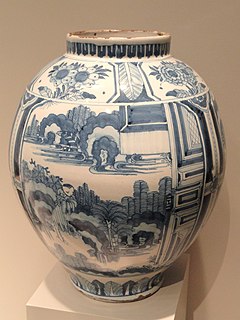
Delftware or Delft pottery, also known as Delft Blue, is a general term now used for Dutch tin-glazed earthenware, a form of faience. Most of it is blue and white pottery, and the city of Delft in the Netherlands was the major centre of production, but the term covers wares with other colours, and made elsewhere. It is also used for similar pottery that it influenced made in England, but this should be called English delftware to avoid confusion.

Faience or faïence is the conventional name in English for fine tin-glazed pottery on a buff earthenware body, at least when there is no more usual English name for the type concerned. The invention of a white pottery glaze suitable for painted decoration, by the addition of an oxide of tin to the slip of a lead glaze, was a major advance in the history of pottery. The invention seems to have been made in Iran or the Middle East before the ninth century. A kiln capable of producing temperatures exceeding 1,000 °C (1,830 °F) was required to achieve this result, the result of millennia of refined pottery-making traditions. The term is now used for a wide variety of pottery from several parts of the world, including many types of European painted wares, often produced as cheaper versions of porcelain styles.

Spode is an English brand of pottery and homewares produced by the company of the same name, which is based in Stoke-on-Trent, England. Spode was founded by Josiah Spode (1733–1797) in 1770, and was responsible for perfecting two extremely important techniques that were crucial to the worldwide success of the English pottery industry in the century to follow.

In different periods of time and in different countries the word majolica has been used for two distinct types of pottery.

A tureen is a serving dish for foods such as soups or stews, often shaped as a broad, deep, oval vessel with fixed handles and a low domed cover with a knob or handle. Over the centuries, tureens have appeared in many different forms, some round, rectangular, or made into fanciful shapes such as animals or wildfowl. Tureens may be ceramic—either the glazed earthenware called faience or porcelain—or silver, and customarily they stand on an undertray or platter made en suite.

"Blue and white pottery" covers a wide range of white pottery and porcelain decorated under the glaze with a blue pigment, generally cobalt oxide. The decoration is commonly applied by hand, originally by brush painting, but nowadays by stencilling or by transfer-printing, though other methods of application have also been used. The cobalt pigment is one of the very few that can withstand the highest firing temperatures that are required, in particular for porcelain, which partly accounts for its long-lasting popularity. Historically, many other colours required overglaze decoration and then a second firing at a lower temperature to fix that.

Mintons was a major company in Staffordshire pottery, "Europe's leading ceramic factory during the Victorian era", an independent business from 1793 to 1968. It was a leader in ceramic design, working in a number of different ceramic bodies, decorative techniques, and "a glorious pot-pourri of styles - Rococo shapes with Oriental motifs, Classical shapes with Medieval designs and Art Nouveau borders were among the many wonderful concoctions". As well as pottery vessels and sculptures, the firm was a leading manufacturer of tiles and other architectural ceramics, producing work for both the Houses of Parliament and United States Capitol.

The Frankenthal Porcelain Factory was one of the greatest porcelain manufacturers of Germany and operated in Frankenthal in the Rhineland-Palatinate between 1755 and 1799. From the start they made hard-paste porcelain, and produced both figurines and dishware of very high quality, somewhat reflecting in style the French origin of the business, especially in their floral painting. Initially they were a private business, but from 1761 were owned by the local ruler, like most German porcelain factories of the period.

Victorian majolica properly refers to two types of majolica made in the second half of the 19th century in Europe and America.

Tin-glazed pottery is earthenware covered in lead glaze with added tin oxide which is white, shiny and opaque ; usually this provides a background for brightly painted decoration. It has been important in Islamic and European pottery, but very little used in East Asia. The pottery body is usually made of red or buff-colored earthenware and the white glaze imitated Chinese porcelain. The decoration on tin-glazed pottery is usually applied to the unfired glaze surface by brush with metallic oxides, commonly cobalt oxide, copper oxide, iron oxide, manganese dioxide and antimony oxide. The makers of Italian tin-glazed pottery from the late Renaissance blended oxides to produce detailed and realistic polychrome paintings.
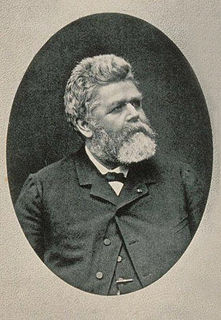
Joseph-Théodore Deck was a 19th-century French potter, an important figure in late 19th-century art pottery. Born in Guebwiller, Haut-Rhin, he began learning the trade in his early 20s, moving to Paris at age 24. In 1856 he established his own faience (earthenware) workshop, Joseph-Théodore Deck Ceramique Française, and began to experiment with styles from Islamic pottery, and in particular the Iznik style.

Gzhel is a Russian style of blue and white ceramics which takes its name from the village of Gzhel and surrounding area, where it has been produced since 1802.
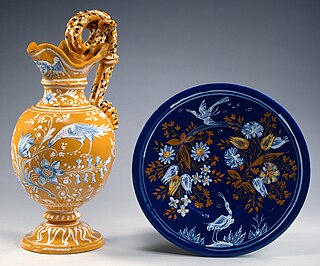
The city of Nevers, Nièvre, now in the Bourgogne-Franche-Comté region in central France, was a centre for manufacturing faience, or tin-glazed earthenware pottery, between around 1580 and the early 19th century, production then dying down to a single factory, before a revival late in the century. In 2017, there were still two potteries making it in the city, after a third had closed. However the quality and prestige of the wares has gradually declined, from a fashionable luxury product for the court, to a traditional regional speciality using styles derived from the past.

The Musée de la Faïence de Marseille is a museum in southern Marseille, France, dedicated to faience, a type of pottery. It opened to the public in June 1995 in the Château Pastré at 157, avenue de Montredon 13008 Marseille. It is planned to transfer the faience museum to the Château Borély, which will also hold the planned Museum of Decorative Arts and Fashion, as part of preparations for Marseille becoming the European cultural capital in 2013.
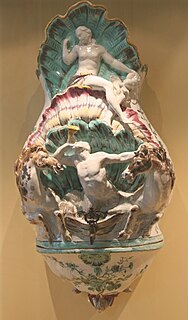
Veuve Perrin was a factory in Marseille, France that manufactured Faïence wares between 1748 and 1803.

Honoré Savy (1725-1790) was the founder of a factory that manufactured faience wares in Marseille, France between 1749 and 1790. He is associated with the Veuve Perrin and Leroy factories.

The Ateliers Clérissy were the main pottery factories making Moustiers faience, operated by members of the Clérissy family in Moustiers-Sainte-Marie in the Alpes-de-Haute-Provence, in Marseille, France and later Varages and elsewhere. Family members continued to produce faïence in different locations until 1733.

Gaspard Robert (1722-1799) was the founder of a factory that made faience in Marseille, France between 1750 and 1793.

Niderviller faience is one of the most famous French pottery manufacturers. It has been located in the village of Niderviller, Lorraine, France since 1735. It began as a maker of faïence, and returned to making this after a period in the mid-18th century when it also made hard-paste porcelain. In both materials, it made heavy use of deep magenta or pink in its decoration.
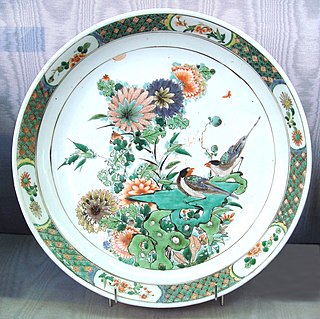
China painting, or porcelain painting, is the decoration of glazed porcelain objects such as plates, bowls, vases or statues. The body of the object may be hard-paste porcelain, developed in China in the 7th or 8th century, or soft-paste porcelain, developed in 18th-century Europe. The broader term ceramic painting includes painted decoration on lead-glazed earthenware such as creamware or tin-glazed pottery such as maiolica or faience.























